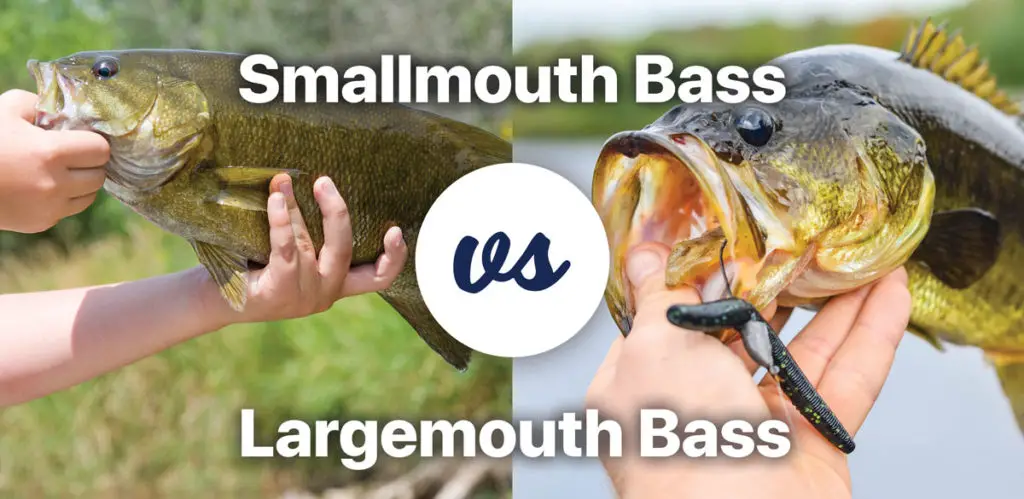Smallmouth and largemouth bass are by all accounts two of the most popular sport fish in America. By some estimates, the bass fishing industry generates about 60 billion dollars a year in fishing equipment, countless tournaments and sport fishing events and other contributions. Several individuals and companies are fully dedicated to fishing these two species.
On a first look, there seems to be no remarkable difference between the smallmouth and the largemouth bass. They both have the same shape and are similar in size. Sometimes, they can be found in the same habitat (they’re both fresh river fish) and they have several traits in common.
However, any bass fishing enthusiast can easily tell that there are key differences between them. To help you better understand smallmouth vs largemouth bass and how to catch them, here’s a handy guide that explains the differences and similarities between them
Differences between smallmouth vs largemouth bass
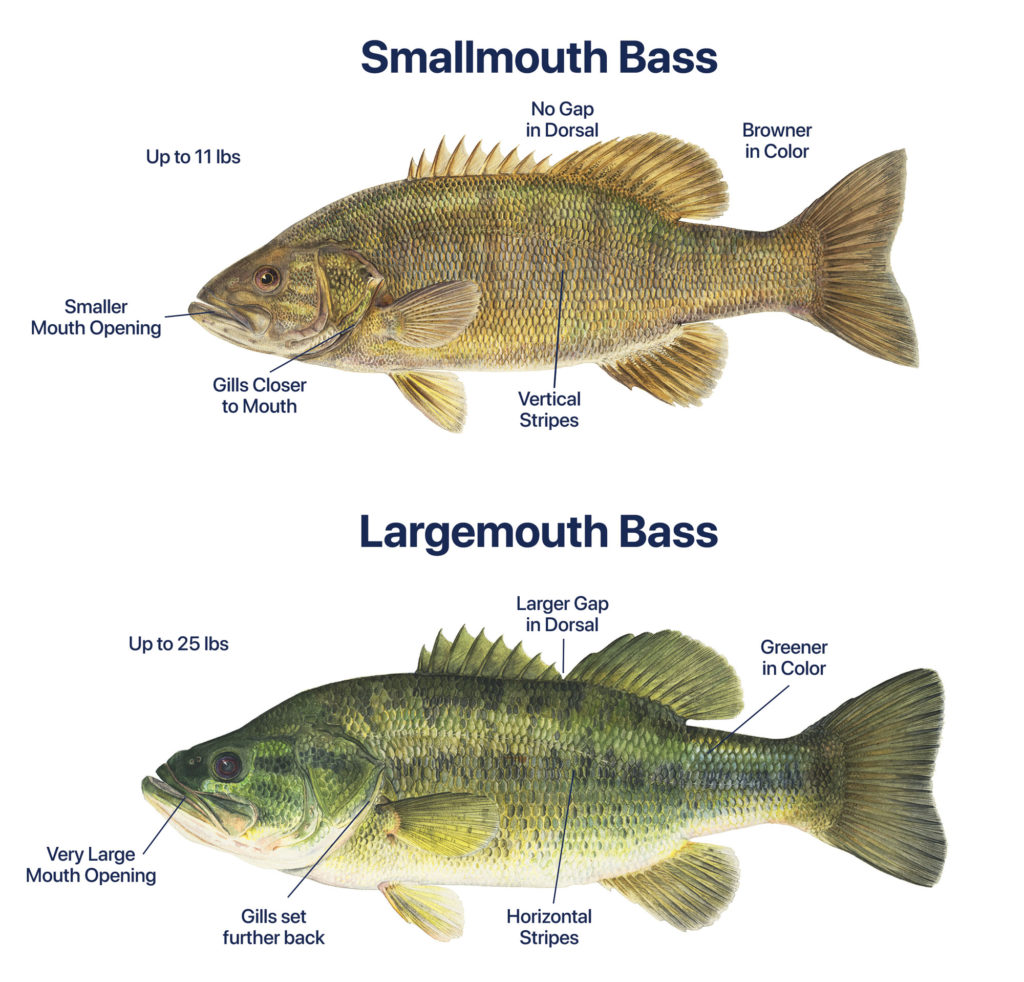
Sometimes the two fish can be hard to differentiate, but fortunately there are a few clear indicators to watch out for.
Size & Weight
The first and most remarkable difference between these two species of the sunfish family is in their size. The largemouth tend to grow larger, reaching sizes of up to 20 pounds. Thus is it the larger fish of the two.
Smallmouths, on the other hand, are a smaller fish species. Their top size is only about half the size of the largemouth. The biggest smallmouth weighs about 10 pounds at their maximum size.
Mouth Size
Like the name implies, largemouth bass tend to have larger mouths. Typically, their upper jaw extends upward beyond the eye. Smallmouth bass have smaller jaws that do not extend past their eyes.
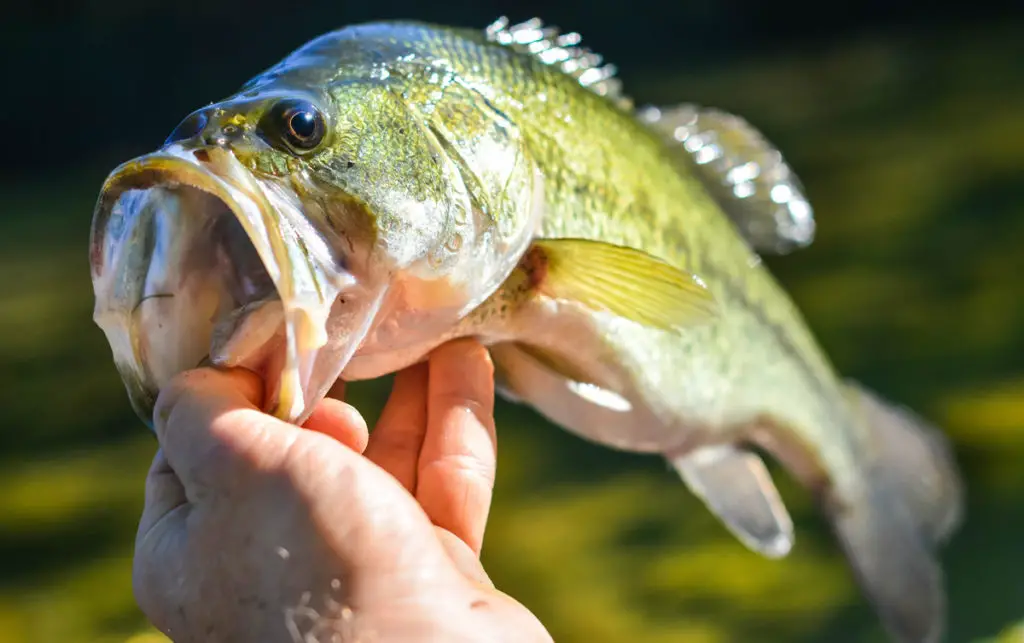
The Fins
If you observe the dorsal fins of the largemouth bass species, you will notice a break between the fins instead of one continuous dorsal fin. This gap is absent in the smallmouth bass giving it a more continuous appearance.
Markings & Color
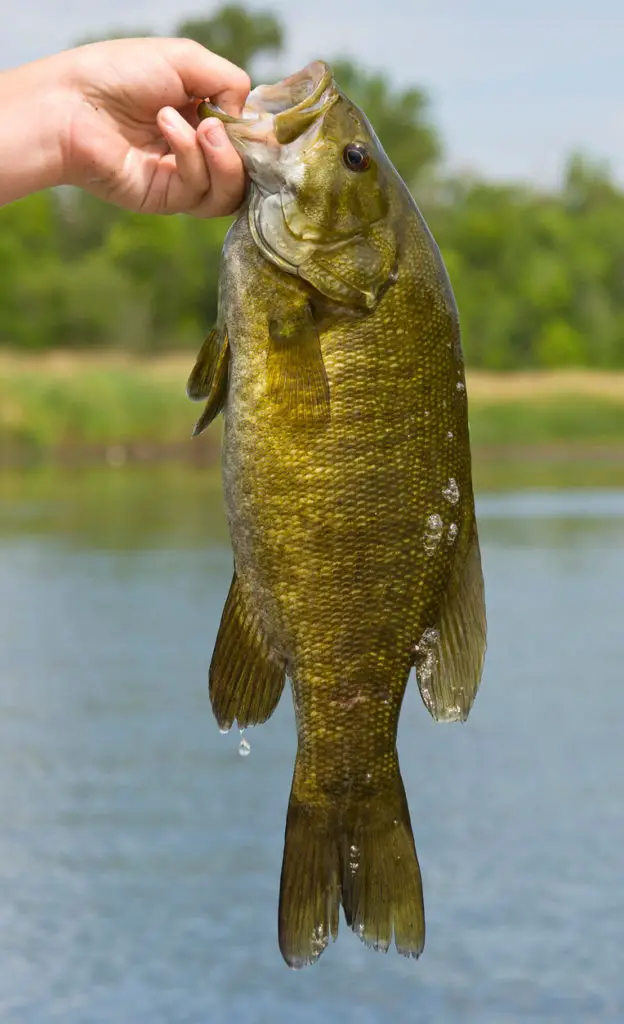
Smallmouth and largemouth bass also differ in their coloring. The largemouth bass is often referred to as green bass or black bass and Smallies have been nicknamed brown bass due to their color.
Of course, color and size are subjective qualities and they may vary depending on the age of the fish and their habitat. Hence, other differentiating attributes are needed especially if you’re not an experienced angler.
Although the color is an unreliable indicator of the difference between these two species, the markings on their bodies are distinct and can be used to differentiate them.
Smallmouth bass typically have vertical stripes on their side. The vertical stripes are usually brown in color which is why they’re often called brown bass.
Largemouths on the other hand have horizontal lines or dark blotches running horizontally across the length of the fish.
Behavior on the Line
You may be able to tell the difference between these two bass species based on how they behave on the line as well. Smallmouths are typically more energetic on the hook than largemouths which is another key difference between them.
They’ll fight hard to get off the hook by jumping which means you’ll need to be skilled with handling them to avoid drop offs. Largemouths are equally strong but not as active.
If you catch a Largemouth bass it’ll jump maybe once or twice in an attempt to get off. But their main play is to try to drag the line into murky water under the cover where it is likely to get tangled with underwater obstacles. Behavior like this can give you an idea of which species of bass you’re dealing with when angling.
Habitat and Geographic Location
In terms of habitat, these two fish species are freshwater fishes and they thrive in rivers, lakes, and ponds. However, each species have their specific preferences when it comes to where they like to live. Generally, Smallmouth bass prefers colder waters which is why they are more commonly found in Northern waters such as Lake Erie.
Large mouth bass on the other hand are fond of warmer water temperatures which is why they’re commonly found in Southern Lakes such as Okeechobee.
When the conditions are right, largemouth and smallmouth bass may also be found in the same waters. However, even when this occurs, they usually won’t be in the same part of the river or lake.
Largemouth Bass Habitat
Largemouth bass prefer clear, sandy, and shallow waters (usually between 2 to 6 feet of water) to deep water. Here they will find abundant aquatic plants in the sandy bottoms where they love to feed and spawn.
They thrive better in warmer waters and can tolerate as much as 80 to 90-degree water temperature during the summer, which is higher than what smallmouths and other fish types can tolerate.
Largies love cover, which is why you’re likely to find them around stumps, rocks, weed beds, brush piles, and thick grass cover.
Although they can be found in lakes and rivers, the largemouth bass doesn’t like strong currents. The largemouth bass hunts by ambushing their prey from their hiding spots in current breaks. Thus, the best place to look out for them is around sheltered breaks or rock piles with thick cover.
Geographic distribution of Bigmouth
As far as geographic distribution goes, largemouth bass is one of the most diverse fish species. Their high tolerance for different temperature ranges means they can be found almost everywhere in the United States with only a few locations off-limits.
Largemouth bass can also be found in some parts of Northern Mexico and the southern regions of Canada, laying further credence to the widespread geographic distribution and the versatility of their habitat.
Smallmouth Bass Habitat
Smallmouth basses are primarily river dwellers, but they can be found in lakes and ponds as well. They are not a big fan of cover like the largies and they hang out around small pea-sized gravel to feed and spawn. They will not enter under thick cover but can hunt around them.
Smallmouth bass will chase prey out into the open water which makes them easier to find in places where the water is clear..
Unlike largemouth bass, smallmouth bass prefers water with cooler temperatures. They have a very low tolerance to pollution and you’re more likely to find them in clean and healthy waters.
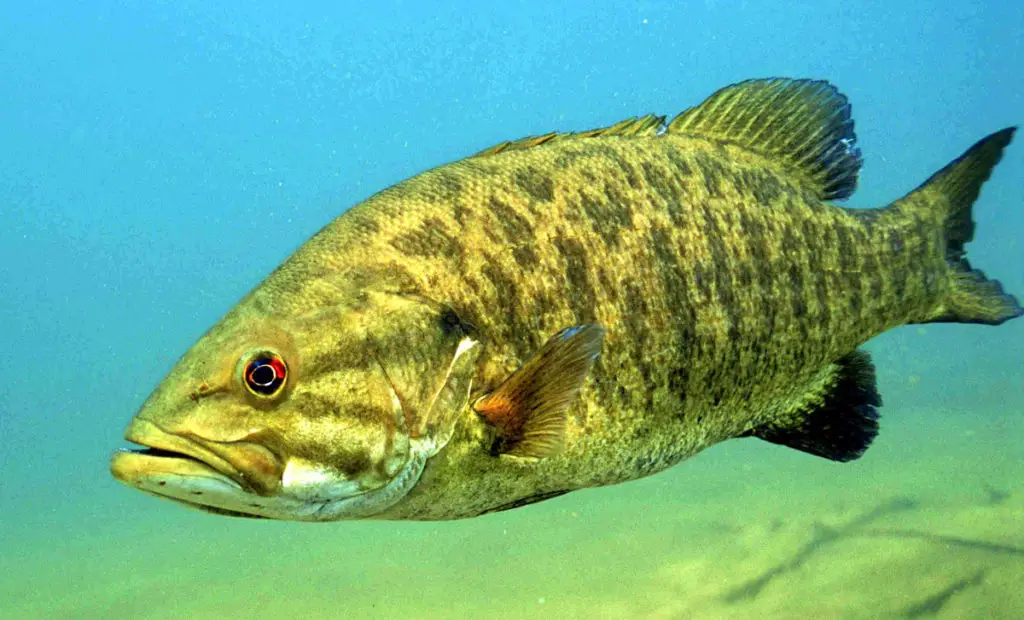
Geographic distribution of Smallmouth
In terms of geographic distribution, the smallmouth bass is not as widespread as their largemouth cousins. They are found natively in the upper Mississippi region and are also abundant in the Great Lakes Region and in the St. Lawrence River.
In addition to these main areas, you may find small populations of smallmouth bass in various locations within the Northern and Western regions of the United States as well as some fishing spots in Canada.
Thanks to artificial stocking, the range of smallmouth bass are gradually spreading down south and in the west.
Best Time of Year for smallmouth vs largemouth bass fishing
So when is the best time to fish for bass? Well, the answer to this depends on where you’re fishing since each water body will have its peak seasons influenced by climate, vegetation, depth, and other factors.
However, for each of these fish species, there are specific rules to keep in mind as far as the ideal fishing time is concerned.
When to Fish for Large mouth Bass
During the warm summer months, you are likely to find largemouth bass in the shallow creeks and bays where there’s sufficient access to good structures like bridge pilings and stumps that they use for cover. This makes summer an ideal time to fish for anyone targeting largemouth bass.
Although opinions vary, many anglers believe that the best time to go fishing for largemouths is on cloudy and drizzly days. You should also watch out for the wind. A slight breezy day is great for fishing, but they’ll be difficult to track down on windy days because they’ll be roaming about instead of staying put.
When to Fish for Small mouth Bass
During the spring season, you’ll find smallmouth bass in the shallow waters where they gather to spawn in rocky areas.
However, as the weather begins to warm up, they’ll move to the deeper water. Smallmouth bass will become virtually elusive and difficult to find by late summer but will return to the shallows again by fall where they’re easier to spot.
The best time to go fishing for smallmouth bass is on a bright day with calm waters. You’ll find it easier to spot them when the waters are clear. Like the largemouths, a lightly breezy day is great fishing time to find smallmouth bass. They’ll be trickier to spot when the winds are stronger.
Fishing Lure and Gear to use for Smallmouth vs Largemouth bass
Since different anglers tend to have their specific preferences when it comes to fishing tactics and lure to use, it’s hard to give a definite word on what would work best for fishing bass.
Different types of baits have been recommended including finesse worms, football jigs, crankbaits, spinnerbaits, and plastic baits.
As for the right tactics to use for this species of fish, there are specific tips to keep in mind depending on the type of bass you’re dealing with.
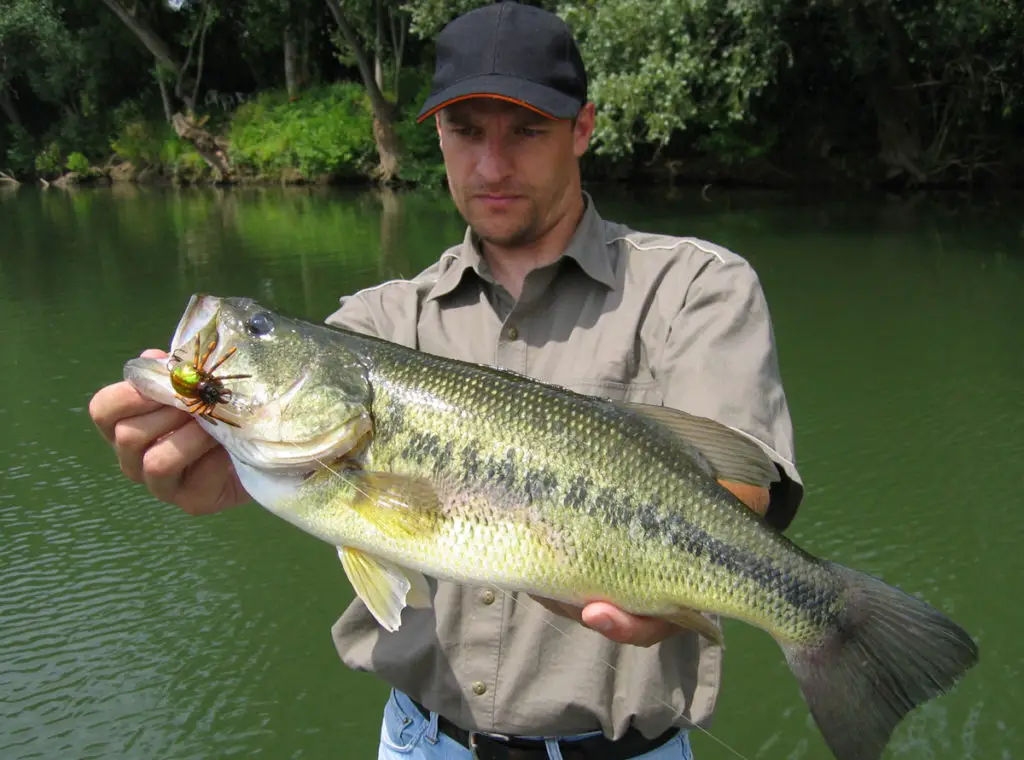
Tips for angling largemouth bass
If you’re aiming to catch largemouth bass, the best tactic to use is to flip and pitch into the grasses where they take cover.
Large-sized soft plastics and jigs attached to a fluorocarbon line with small bait fish will work best in most cases because they get as close as possible to the fish. This is important since a largemouth bass may ignore your lures unless it is very close to it. a
The largemouth bass tends to occupy habitats with heavy vegetation cover. Your choice of gear has to put this into consideration as well. Baitcasting rods are better for catching largemouth bass than spinning rods. They are better suited for plowing through obstacles underwater and give you better control.
Tips for angling Smallmouth Bass
Smallmouth Bass can be lured using any type of bait. They’ll take vibrating jigs, crankbaits, and spinnerbaits. In fact, some smallmouth bass has been known to come up to the surface to take topwater plugs.
However, even though they’re quick to take bait, you’re less likely to be successful if you use a heavy line. They have better vision than largemouth and they are likely to spot the line. Hence, your best bet is to catch smallmouth bass is to use a light line.
You can use any type of medium action bait caster or spinning rods for smallies. You should bear in mind that you will be fishing in fast-moving water. This means your line should be strong enough to withstand the current without seeking too deep to the point where it sinks lower than the bass.
Conclusion
Since they feed on the same things and they’re quite similar in their appearance, behavior, and habitat, fishing for large and smallmouth bass is a comparable experience. Although a lot of beginners have a hard time telling them apart, paying attention to these tips will help you recognize the obvious difference between them and prepare you better for a bass hunting adventure.

Researched and written by the American Gun Facts team. We are a group of Americans dedicated to providing factual information on firearms and fighting back against attempts to weaken or discard the Second Amendment. We write on topics ranging from firearm statistics, news, reviews, and more! AGF has been featured in the New York Times, NBC, MSN, Time, & many other publications.
